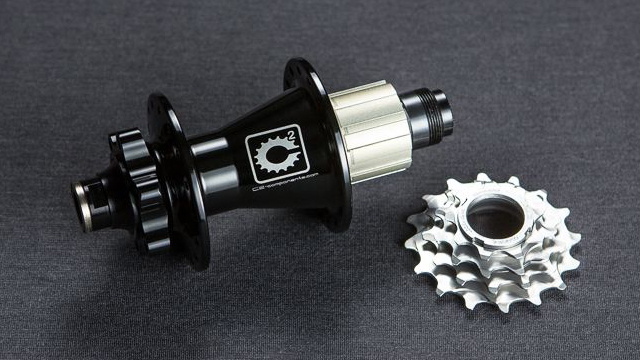Microdrive hub allows for 9-36t range

With all the talk about wide-range 1×11 drivetrains and chainring-sized range-extending cassette cogs, not much has been said about the opposite end of the block. Sure, SRAM’s XX1 and X01 drivetrains go down to a 10t cog, but going that route requires buying into the entire excellent, but pricy, 1×11 system. Back in 2011 or so, Canfield Brothers saw the need for a bit more range for single-ring setups but decided to work their magic where small changes make the biggest difference. The result is a hub with a truncated freehub body and cassette stub that will allow for a 9-36t range when used with the top portion of standard cassettes.
Being hub-based, Canfield Components’ 9t Microdrive system will require a newly-built rear wheel using their 348g model- but every system comes with its costs and compromises. While, if SRAM is to be believed, the 9t cog might pedal a bit lumpily, the system’s 9-36t cassette will provide a tidy 400% range, sitting neatly between OneUp’s 11-42 mod (382%) and SRAM’s 10-42 cassettes (420%). Jumps between gears are relatively small, so most 10s rear derailleurs should shift as intended. Doesn’t sound like a bad solution, does it?

The rear hub retails for $300 (currently on sale for $150/£92) and kits including the hub, cassette stub, and lockring tool sell for $380 (on sale for $230/£141). Hopefully the slashed prices don’t mean the end is near for what seems like a neat solution. We’ve been in touch with the Brothers Canfield and despite the price cut, there’s more 9t Microdrive on the way. From Canfield Brothers:
The Canfield Brothers continue to innovate and introduce new products to help you go fast and make your bike better! This is the latest in our collection. The C2 9T micro-drive hub. With this hub you have the ability to run a cassette down to a 9 tooth. This hub is designed around a custom step-down free hub body allowing the fitment of a 10t and 9t cassette cog. The difference between the 11t and 9t is about 20%.
What does this mean? For XC riders you have the option of running a 1x set up with a 9-32/36 cassette. You can also run a 2x or 3x setup for the ultimate gear range. For DH riders, a 9-26 fit’s the bill nicely. With this cassette you are no longer required to run the typical 36-40 chain ring. Remember the 10t is 10% taller than an 11t. And the 9t is 10% taller than the 10t. There’s your 20% difference in gearing. This in combination with the new micro chain guide offerings, allow a chain ring of 28-32. You will gain BB clearance, have less chain and have a more compact overall drivetrain.






Recumbent owners have been bodging something very similar for years using Shimano Capreo cassette and custom freehub bodies:
http://sheldonbrown.com/capreo/index.html
Hmm, could you combine it with http://singletrackworld.com/2013/12/oneup-components-releases-range-extending-42t-cog/ for 9-42 = 467 (ish) %?
Scratches head – just use a slightly bigger chain ring?
@buzz presumably the point is to use a smaller chainring so get a lower lowest gear without sacrificing range at the top. But I agree it’s not really clear.
And why does this system need a new hub if it’s just switching the top of a regular cassette?
There was a system shown recently that used a 42T cog at the bottom of the cassette, with a cog from the middle sacrificed. But that means more chain and possibly derailleur compatibility issues. Is the Canfield system intended to avoid those problems?
Buzz-Lightyear,
This should be viewed in terms of the range provided by a cassette. The challenge around 1x drivetrains comes from their lack of range (or difference between highest and lowest gear, usually measured in %). Regardless of chainring size, a standard 11-36 provides a 327% range- not terribly wide. A 10-42 XX1 or X01 cassette provides a 420% range, which approaches the 436% that the first two chainrings in a Shimano (24-32-42) triple does. A SRAM (24-36 or 26-39) double is up at 491%, a full Shimano triple provides 573%.
When looking at a single ring setup, it’s key to look at the range provided. The specific ratios (or, when wheel size is considered, gear inch measurements) can be tailored via different chainrings.
Hope that makes sense!
Marc
Mattjg,
Exactly- as well as to improve ground clearance by going smaller. That said, the Canfield system predates the OneUp system (story linked in the text) by a couple of years.
Marc
Dr. Rad,
Thanks for that! It looks like Canfield Components is using the Capreo interface for their setup.
Why does this system need a custom hub?
Presumably because the 9 toothed cog is simply too small a diameter to fit “over the top” of a std sized freehub i guess!
@max ok makes sense, the copy says “truncated” which I took to mean “less wide”
& the rest of the cassette would need to sit on some kind of shim
the whole thing’s too much faff for me
whizzzzzzzzzzzzz straight over my head.
ride the bloody bikes
Sounds like a terrible “solution” to me.
I don’t normally comment but hasn’t everyone missed the point.
Getting a decent range with a smaller lighter solution rather than sticking a dinner plate on the back and allowing a smaller front ring and not the expense of 11 speed has to be a good idea, isn’t it?
It’s not cheap Ed, you have to buy the hub and build a wheel on it, the micro-cassette widget (repeat when worn out), throw away the top of a normal cassette, and if you want the result to be extending the range downwards, a smaller chainring too.
At least the 1-up alternative (a 42T for which you sacrifice a 17T) doesn’t need a new wheel.